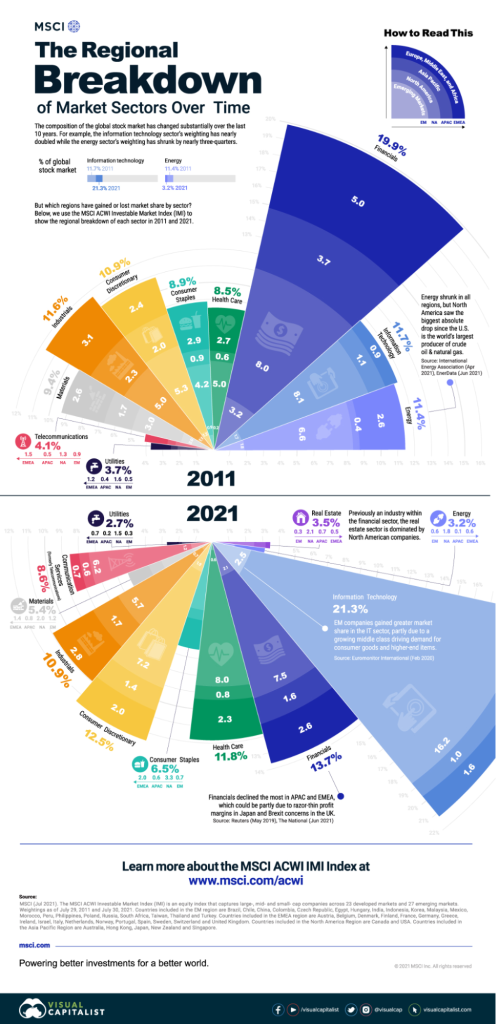지역: 유럽 경제의 주요 주식 부문
수업 학습 목표:
- 소개: This section explores the key stock sectors in the European economy, emphasizing their roles in driving economic growth and responding to various macroeconomic factors, regulatory environments, and consumer trends.
- Understand the dynamics of the energy sector in Europe, including the impact of government policies on renewable energy initiatives and the major companies like BP and Ørsted that are pivotal in this transformation. Recognizing these elements helps anticipate shifts in energy production and investment opportunities.
- Gain insights into Europe’s financial sector, including the influence of ECB policies and the challenges faced by major banks like HSBC and Deutsche Bank. This knowledge is crucial for understanding the factors that affect financial market stability and profitability.
- Explore the automotive sector, noting how consumer demand and regulatory changes toward sustainable transportation, such as EVs, drive innovation and sector growth, with companies like Volkswagen and Daimler at the forefront.
- Analyze the pharmaceuticals and healthcare sector, focusing on the drivers such as the aging population and regulatory environments that influence companies like Roche and Sanofi. This sector’s growth provides insights into healthcare demand and investment potential.
6.1 Key Stock Sectors in the European Economy
In Europe, several stock sectors play a critical role in driving economic growth. Each sector is influenced by different macroeconomic factors, regulatory environments, and consumer trends. Here are some of the key stock sectors in the European market:
- 에너지 부문: Europe’s energy sector is heavily influenced by government policies aimed at reducing carbon emissions and increasing the use of renewable energy sources. Countries like Germany and France have made significant investments in wind, solar, 그리고 nuclear energy. The sector includes companies involved in the production and distribution of energy, such as BP 그리고 Royal Dutch Shell, as well as renewable energy firms like Ørsted.
- Key Drivers: Energy policies, commodity prices, and technological advancements in renewables.
- Major Industries: Oil & gas, renewable energy, and utilities.
- 금융 부문: Europe’s financial sector includes some of the largest banks, insurance companies, and investment firms in the world. Major players like HSBC, BNP Paribas, 그리고 Deutsche Bank operate across the continent. The sector is highly regulated, with European Central Bank (ECB) policies playing a significant role in determining profitability.
- Key Drivers: Interest rates, regulatory changes, and economic growth.
- Major Industries: Banking, insurance, and asset management.
- Automotive Sector: Europe is home to some of the world’s largest and most well-known automotive manufacturers, including Volkswagen, Daimler, 그리고 BMW. The sector has been at the forefront of innovation in electric vehicles (EVs), with Germany leading the push toward sustainable transportation.
- Key Drivers: Consumer demand, technological innovation, and environmental regulations.
- Major Industries: Automobile manufacturing, electric vehicles, and auto parts.
- Pharmaceuticals and Healthcare: Europe’s healthcare sector is dominated by companies like Roche, Sanofi, 그리고 GlaxoSmithKline, which are leaders in drug development, biotechnology, and medical devices. The sector has seen significant growth due to the increasing demand for healthcare services, especially as Europe’s population ages.
- Key Drivers: Aging population, government healthcare spending, and regulatory approvals.
- Major Industries: Pharmaceuticals, biotechnology, and healthcare services.

수치: The Regional Breakdown of Market Sectors Over Time
설명:
The figure compares the regional distribution of global stock market sectors between 2011 and 2021 using the MSCI ACWI Investable Market Index. It illustrates how the sectoral composition has shifted over the past decade, showing changes in the weight of each sector, such as the growth in 정보 기술 and decline in 에너지. The chart also highlights sector-specific trends and variations across different regions, including APAC, North America, EMEA, and Emerging Markets (EM).
주요 시사점:
- Information Technology’s share nearly doubled from 11.7% in 2011 to 21.3% in 2021, reflecting rapid digital growth.
- Energy’s share significantly declined from 11.4% in 2011 to 3.2% in 2021, largely due to a global shift toward renewable energy.
- 금융 remained the largest sector, despite decreasing from 19.9% in 2011 to 13.7% in 2021.
- 보건 의료 그리고 임의소비재 sectors saw notable growth over the decade.
- Regional differences, like the dominance of 금융 in APAC and EMEA, highlight sectoral variations across geographies.
정보의 응용:
This data helps investors understand sectoral shifts 그리고 regional trends in global markets over time. By analyzing sector performance, investors can identify potential growth opportunities and diversify their portfolios based on emerging sectors like 정보 기술. This information is useful for making informed investment decisions and evaluating market trends.
주요 수업 정보:
- 그만큼 energy sector is evolving due to a significant shift towards renewable energy, influenced by stringent government policies aimed at reducing carbon emissions, which impacts companies involved in traditional and renewable energy production.
- In the financial sector, fluctuating interest rates and stringent regulatory frameworks are pivotal in shaping the operations and profitability of Europe’s major banks and financial institutions, affecting overall market stability.
- 그만큼 automotive sector is undergoing a transformative phase with increased emphasis on electric vehicles, driven by innovation and environmental regulations, which are reshaping consumer preferences and manufacturing strategies.
- 그만큼 pharmaceuticals and healthcare sector sees continuous growth driven by an aging population and increased healthcare spending, making it a critical area for investment and development, particularly in drug development and biotechnology.
- Sectoral shifts in the global market are highlighted by the growth of Information Technology and the decline of the Energy sector, emphasizing the importance of understanding regional trends and market dynamics for strategic investment and portfolio diversification.
마무리 진술
Recognizing the key sectors within the European economy and their respective drivers, challenges, and growth opportunities enables investors and policymakers to make informed decisions. This understanding helps in navigating the complexities of the market, capitalizing on emerging trends, and fostering economic resilience.

